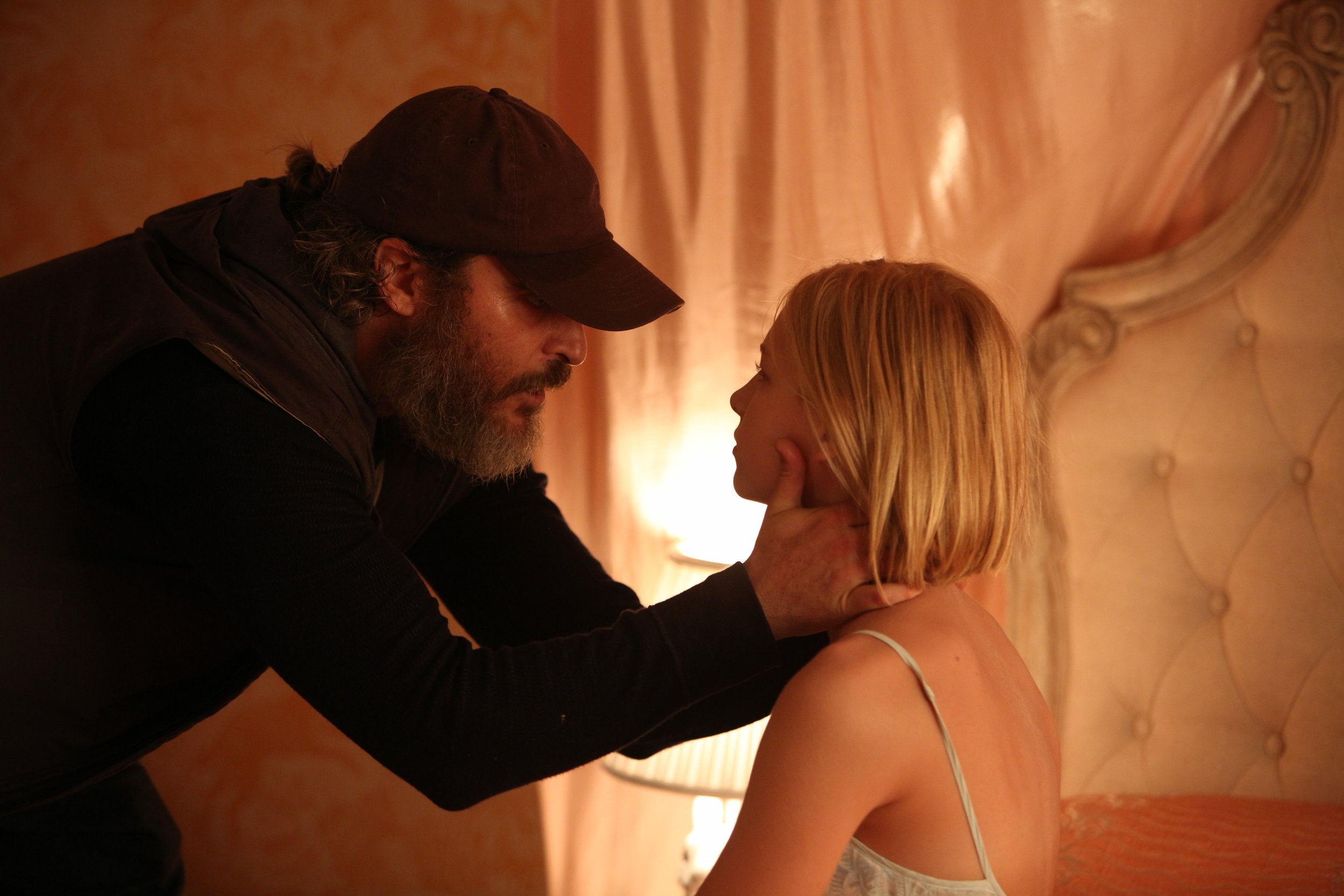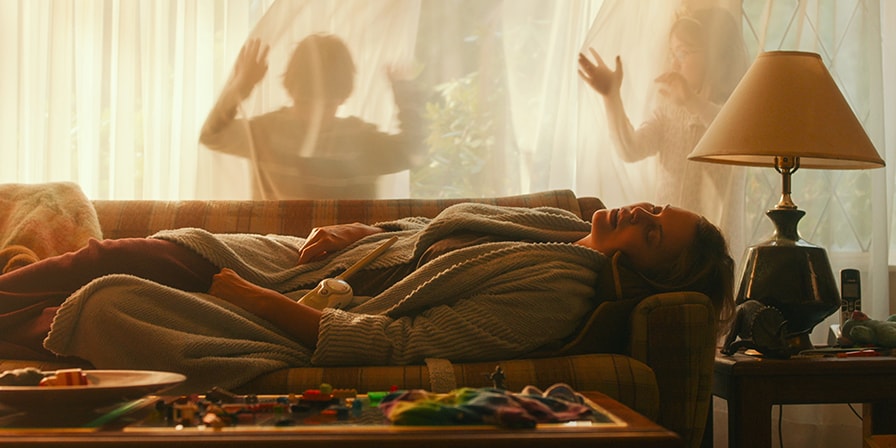Bloodshed in Suburbia
By Sophia Larigakis | 11.03.2019
Safe. Dir. Todd Haynes. 1995. Film.
In an uncharacteristic move to “try something new,” Carol White gets a perm in a green marble, mirrored room. Carol, a hesitantly self-described “homemaker,” suffers from a mysterious and multi-symptomatic illness despite (or because of) her profoundly insular, conventional, and hermetic world. Todd Haynes’ 1995 film Safe is an elegy to suburban paranoia. The film works simultaneously to enmesh Carol in the soft pinks and teals and marble gloss of her “ideal” life, and to bury her alive under the weight of their constricting conventionality. She is both inextricable from her surroundings and poisoned by them. In her text “Dangerous Spaces: Safe,” Susan Potter elucidates this double bind by detailing the ways in which Carol’s institutional and domestic environment contains and constrains her. Potter calls attention to Haynes’ cinematic preoccupation with “what envelops… and defines the body and its boundaries” (2004: 148). The beauty salon sequence in Safe enacts a deliberate construction of gendered bodily and social boundaries, only to explicitly reveal and undermine the superficiality of those confines.
In “Dangerous Spaces,” Potter places Safe in dialogue with conceptions of genre and queerness. Potter posits that Haynes “queers” traditional genre, such as the Hollywood romance, by undermining cinematic convention and heteronormative (exclusionary) historicization, thus distorting “conservative genre” into “the service of non-normative aims and outcomes” (126). She claims that Haynes conceptualizes the symptoms of Carol’s unnamed illness as “crises of space” (Potter 135). Carol’s crisis is that she is wholly, claustrophobically, enveloped in her space, yet unable to navigate it with autonomy. Carol is both symbolically and architecturally “confined” within the many layers of framing and excess that she inhabits (Potter 137). Potter positions her argument in contrast with the typical reading that Carol is void of identity, and that this lack of subjectivity is the reason for her illness. Instead, Potter suggests that Carol’s illness and identity are “one and the same thing” – entwined in a struggle with her environment (137). Potter defines identity like the diagnosis of an illness, as “an attempt to provide coherence to and explanations for a body of symptoms” (148). For Potter, identity is a desperate attempt to make meaning and construe significance from the consolidation of disparate characteristics. Carol attributes her illness to artifice; the result of living in a chemical and contaminated world. However, Potter suggests that Carol’s environment is not making her sick in the way she believes it to be. Rather than the threatening, external world of pollution and plastics, it is the interior, domestic, social infrastructure that renders her unwell. Both Carol’s illness and identity, Potter claims, are defined by and embodied through the character’s relationship to the structures – physical, institutional – that enclose her.
At a beauty salon, Carol is shown getting the perm and manicure she asks nervously for in the previous scene. This sequence is situated within a profoundly less realist and more abstract cinematic space than the scene which precedes it; it is defined aurally by soft, otherworldly notes straining against the sounds of bubbles as if within a fish tank. These sounds serve to distance the sequence from the space in which it is supposed to be taking place. The previous scene positions the beauty salon as a setting for traffic noise, generic pop music, and general hubbub. In the actual grooming sequence, however, all of the visual and aural noise initially associated with the beauty salon has vanished. Fragments of Carol’s pale body are all that the viewer has access to; the rest of each frame is out of focus. These stylistic devices disorient the spectator, resulting in a sonic and visual unmooring. Carol is completely detached from her surroundings and seemingly free from her endlessly constrictive environment. There are none of the usual doorways and material excesses to frame and restrict her body. She is also, however, anchored in an (perhaps more unnerving) absolute nothingness. In this sequence, Carol is cinematically amputated, suspended in a kind of postmodern placeless space. This placelessness visually echoes Potter’s reading of Carol as existing “in an unrelenting present” (138) – she is past-less, future-less, completely dislocated from any temporal indicators of a different mode of life. Safe, Potter claims, “never suggests that there is some happier past to which Carol might return or that she might recover” (138). Afloat in a celluloid blur, Carol is both free from the life that reifies and restricts her and simultaneously entrapped anew. She is abstracted from her oppressive environment for the first time, but this moment of detachment offers no release, no immunity in itself.
At a microcosmic level, the visual and temporal detachment shared by Carol and the formal features of this scene reenact her endless struggle with and for absolute hermetic containment; neither too much place (confinement) nor too little (dissociation) offer Carol a cure for her affliction. At the beginning of the sequence, Carol’s auburn hair, tightly wound in small curlers, is shown being treated with a liquid held by a disembodied, white-gloved hand. As Carol tilts her head back slowly, her scalp is rendered as landscape; its terrain as alienated and abstract as the network of Los Angeles highways that reappears as a motif in the rest of the film (Potter 128). Her head – faceless in these shots – is then wrapped up in clear plastic, evoking images of quarantine or contagion. In the next shot, the camera grants Carol a face, though in profile. The hard plastic dome of a rigid bonnet dryer is lowered down over her head like a space helmet. The following image then shows Carol’s disembodied hand and wrist getting ‘its’ nails painted. These consecutive shots of the careful administering of plastic protective layers between body and environment are significant in relation to Potter’s argument that Safe is more visually concerned with “what envelops [the body]” and “what defines… its boundaries” than the body itself. Suburban upper middle-class femininity is here performed as an erection of boundaries (Potter 148). These successive class-bound and gendered acts are shot with such deliberate slowness and shallow depth of field that the result is a resemblance to ritual; the act of ‘feminization’ is here a solemn affair of near-religious significance.
Potter contends that the boundaries repeatedly implanted between Carol and her environment throughout the film serve to protect “against an exterior world presumed to be hostile” (137). The boundaries in this sequence serve similarly to feed a fantasy of protection. The salon is the stage whereupon this symbolic armament is enacted. The emphasis on the layers of synthetics placed, as carefully as an embalmment, between Carol’s body and her environment in this scene suggests that polished and buffered ‘femininity’ is as powerful an illusory wall as any architectural structure. In her essay, Potter suggests that “identity is produced from a kind of vacuum, a fantasy of the mastering of a space that threatens to annihilate” (148). The ritualistic construction and re-envisioning of Carol’s body as conventionally feminine – this careful composition of exterior sociality – serves also to arm Carol against the void “space,” the vulnerable vacuity of her own lack of self-knowledge (Potter 148). Carol’s reification, the way in which she is rendered as an object, is imposed on two levels. She is so bound to her environment that it infiltrates her body and poisons her, she internalizes it; and, by way of the denial of her subjectivity – her complete lack of autonomy and blind adherence to restrictive gender norms, her profound lack of a sense of self.
Safe. Dir. Todd Haynes. 1995. Film.
When Carol’s perm is revealed to her at the end of the scene, she is granted only a few seconds of timid appreciation before her nostril pools with vivid dark blood. The slow, insular ritual of the previous shots is punctured by the startling violence of her bleeding nose. This intrusion of blood – of visible illness – into the pastel-hued sanctuary so perfectly built in the earlier shots is as violent as a mutilation. In her essay, Potter places Safe in contrast with Mark Garrett Cooper’s reading of traditional film narratives as “work[ing] to create multiple disconnected spaces… only to reunite those spaces at the end of the film into a single ‘homogeneous, safe space’” (140). Not only does Haynes’ film work to undo and subvert this narrative structure, as Potter suggests, it also reverses it. Spaces presumed, or carefully constructed, to be safe (including Carol’s body), are rendered unsafe by Haynes’ filmmaking. The myth of female perfection, dreamily constructed in the beauty salon, is ruptured by the violence of Carol’s nosebleed. Sealed suburban domesticity, a pseudo-utopian environment designed to preserve violent mythology of otherness (some deserve to be within these walls, others deserve to be outside of them) is cleaved open like a wound by the contagion of Carol’s normative, “safe” body.
That the pseudo-shield of femininity, a ritualistically assembled boundary, between Carol’s vulnerable body and her environment is ruptured so swiftly by the surprising violence of a nosebleed suggests that the boundary’s own wreckage is like that of a fortress under friendly fire. Carol’s internalization of the restrictiveness of her environment – stifled domesticity, objectification, denied autonomy – in the form of illness speaks both to the brutality of these restrictions and to the way in which they are in some sense self-constructed, self-imposed. It is because the boundaries between Carol and her “toxic” environs are so painstakingly constructed and upheld, even to the point of sickness, that the ruptures in their smooth surfaces are so much more violent, so much more personal.
More by Sophia Larigakis
Also Read
Click here for works cited in “Bloodshed in Suburbia”





